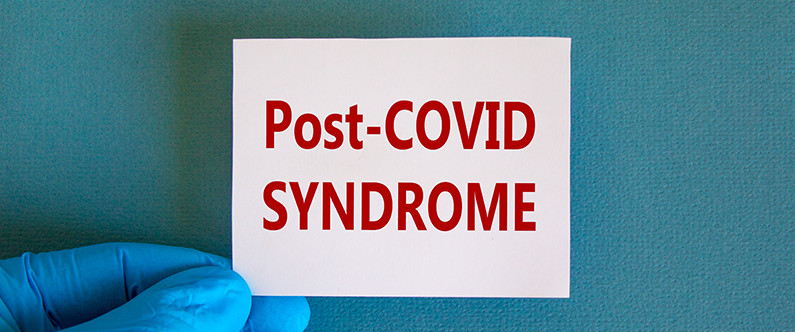Long COVID or Post-COVID-19 Syndrome
 Long COVID consists of a wide range of signs and symptoms that people can experience four or more weeks after first being infected with SARS-CoV-2
Long COVID consists of a wide range of signs and symptoms that people can experience four or more weeks after first being infected with SARS-CoV-2
Although most people with coronavirus disease 2019 (COVID-19) recover completely within a few weeks of illness, some people continue or develop signs and symptoms, which persist for months. This condition has been called ‘post-COVID-19 syndrome’, ‘long COVID’, ‘long-haul COVID’, or ‘chronic COVID’.
Long COVID consists of a wide range of signs and symptoms that people can experience four or more weeks after first being infected with SARS-CoV-2. Older people and those with health conditions (e.g., high blood pressure, diabetes, and obesity) are more likely to experience long-term effects. Even people who had mild COVID-19 symptoms or were asymptomatic can have long COVID.
Common signs and symptoms that characterize long COVID are:
| Lost or distorted sense of smell and taste |
Cough |
| Shortness of breath or difficulty breathing |
Fever |
| Fast heartbeat, also known as heart palpitations |
Joint or muscle pain |
| Tiredness or fatigue |
Rash |
| Changes in the menstrual cycle |
Diarrhea |
| Symptoms that get worse after physical or mental activities |
Chest or stomach pain |
| Memory or concentration problems, sometimes referred to as "brain fog" |
Sleep problems |
| Dizziness on standing (lightheadedness) |
Mood change |
| Headache |
|

Auto-immune conditions and multi-organ damage after COVID-19 illness
Some patients with severe COVID-19 illness experience autoimmune conditions or multi-organ damage with symptoms lasting weeks or months after the acute COVID-19 illness. Autoimmune conditions occur when the immune system attacks healthy cells in the body, causing inflammation or tissue damage in the affected parts of the body.
The organs that may be affected by COVID-19 include:
- Lungs: COVID-19-associated pneumonia can cause long-standing damage to the alveoli (small air sacs in the lungs). The scar tissue resulting from COVID-19-associated pneumonia can lead to long-term breathing problems.
- Brain: COVID-19 illness can increase the risk of strokes, seizures, and Guillain-Barre syndrome — a condition that causes temporary paralysis—even in young individuals. COVID-19 may also increase the risk of developing Parkinson's disease and Alzheimer's disease.
- Heart: Damage to the heart muscle has been observed months after recovery from COVID-19 (also seen in individuals who experienced only mild COVID-19 symptoms). This heart damage may increase the risk of heart failure or other heart complications in the future.
Blood clots seen during COVID-19 illness can be responsible for heart attacks and strokes when they are large, while very small blood clots are believed to cause much of the COVID-19 associated heart and lung damage. These blood clots can also affect liver, kidneys, and legs.
Although it is very rare, some adults and children experience multisystem inflammatory syndrome during or immediately after COVID-19 illness. This condition can happen when some organs and tissues become severely inflamed.

Mental health effects of COVID-19 illness
Post-intensive care syndrome, depression, and anxiety have been observed in patients who have recovered from severe COVID-19 illness after being treated with mechanical breathing assistance in intensive care units. Post-intensive care syndrome involves severe weakness, problems with thinking and judgment, and post-traumatic stress disorder, which involves long-term reactions to a very stressful event. These mental health conditions are probably also exacerbated by other effects related to the COVID-19 pandemic, including mental health effects from isolation, negative economic situations, and lack of access to healthcare for managing underlying conditions.
Prevention
The best way to avoid long COVID is to prevent SARS-CoV-2 infection in the first place. It is important to protect ourselves and our families by following the safety measures outlined below:
- Try to maintain a physical distance of at least one meter from others
- Avoid large gatherings or crowded spaces where you may be in close contact with others
- Wear a facemask when away from home
- Cough or sneeze in your bent elbow or tissue (not your hands)
- Avoid close contact with someone who is sick
- Avoid shopping during peak hours when markets and malls are most crowded
- Maintain a healthy lifestyle, such as nutritious eating, regular exercise, getting restful sleep, and quitting tobacco use
Vaccination against COVID-19 can also help prevent COVID-19 long-lasting effects, as vaccination reduces the risk of severe COVID-19 illness. Refer to the Ministry of Public Health Qatar’s webpage for frequently asked questions about the vaccine.
Sources: HopkinsMedicine.org | Center for Diseases Control and Prevention | MayoClinic.org
Authors: Dr. Karima Chaabna and Dr. Sohaila Cheema
Editing: Mr. John Hayward